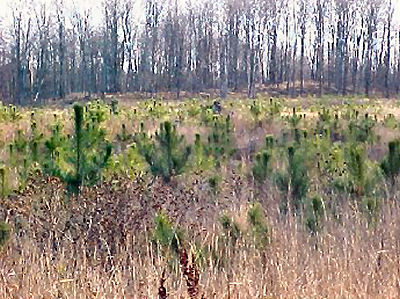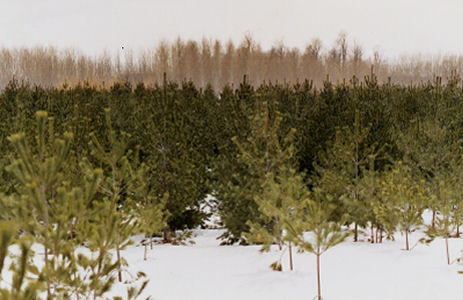| Introduction | Forest Types | |
| Forest Characteristics | Management | |
| Forest Contributions | Special Considerations | |
| The Forest Plan | Assistance |
![]()
FOREST MANAGEMENT GUIDELINES FOR MICHIGAN |
| Introduction | Forest Types | |
| Forest Characteristics | Management | |
| Forest Contributions | Special Considerations | |
| The Forest Plan | Assistance |
![]()
FOREST MANAGEMENT GUIDELINES FOR MICHIGAN |
Regeneration and Reforestation
Regenerating the forest after harvest is a necessary part of sustainable forest management. Regeneration is accomplished either by natural or artificial means.
Natural regeneration methods
Properly harvested, many tree species regenerate themselves either by suckering (e.g. aspen), stump sprouting (e.g. red maple, paper birch, oak), or seeding (e.g. northern hardwoods, oak). Several conifers (e.g. spruce, balsam fir, white pine, cedar, hemlock, tamarack) also regenerate naturally from seed. The vast majority of trees in Michigan are regenerated naturally. Cedar and hemlock are slow-growing and are preferred browse species for deer, and as a result, natural regeneration of these species is usually only successful where deer populations are low. Where deer populations are high, natural regeneration of other species, particularly in oak and northern hardwood stands, may also be threatened. To assess local deer impacts on regeneration, it is a good idea to observe regeneration and browse conditions in nearby stands harvested within the last five to ten years. Deer browsing can substantially alter the tree composition and other aspects of the future forest.
Artificial regeneration methods
Red pine and jack pine are commonly regenerated by planting seedlings (Figure 16). Proper site preparation and planting methods must be followed to minimize seedling mortality. To prepare a site for planting, competing vegetation must be controlled and slash, e.g. logging residue, reduced to improve conditions for seedling survival and to make the planting job easier. Common methods of site preparation include herbicides (which kills vegetation but doesn’t reduce the slash), furrowing, and patch scarification (exposing mineral soil). Patch scarification removes the sod layer from approximately a 2 foot square area which is critical before planting. Even light sod will create problems for young seedlings competing for moisture and nutrients, especially on drier sites. The proper method of planting includes making sure the seedling is inserted into the planting hole with the root collar at the soil surface and with its roots straight down, not twisted to the side or folded (J-rooted). After the seedling is properly placed, the hole must be completely closed with firm pressure from the foot or heel. All air space in the root area must be closed or the roots will dry out. During the few years after planting, competing vegetation may need to be controlled in order to minimize seedling mortality.


Figure 16. Young red pine plantation (left) and well established white pine plantation (right)..
Selection of species, type of planting stock, and spacing is dependent upon the owner's objective(s) and site conditions. The forest owner is always wise to select species and methods which are suited to the local soil and climate. When mixing species on a planting site, be certain that they have similar growing requirements and are compatible with each other. Contact a forester for more detailed recommendations and guidance.
Red pine can be regenerated from seed using a shelterwood system and scarification but the risk of failure is higher. Seed production is quite variable from year to year and mature red pine standing over young seedlings may harbor a damaging fungus (Diplodia) that can harm or kill young seedlings. Jack pine may be successfully regenerated from seed in the cones left after harvest. To accomplish this, slash must be uniformly distributed across the site. Scarification from logging activity is seldom adequate, so additional scarification using anchor chains or roller chopping is necessary to prepare a mineral soil seedbed. Regeneration attempts that do not include a scarification treatment rarely succeed in jack pine stands.

This website is maintained by Bill Cook, Michigan State University Extension
Forest in the Upper Peninsula. Comments, questions,
and suggestions are gratefully accepted.
Last update of this page was 9 January, 2014
This site is hosted by School of Forest Resources and Environmental Science at Michigan Technological University.